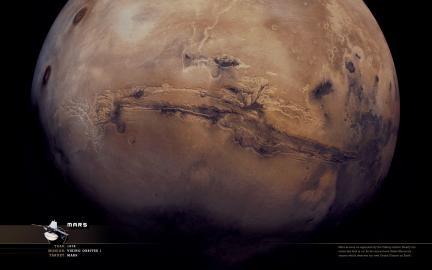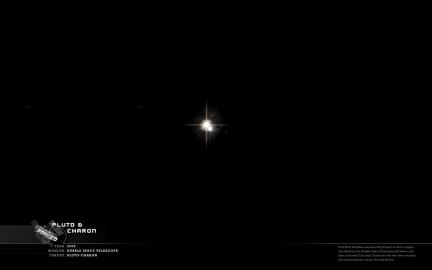 Just for old times sake, I made the effort to post some kind of imagery of Pluto to complete the “classic” planetary set most of us have grown up with. For years scientists have pressed NASA to prioritize a mission to the only planet left in the solar system that has yet to be visited by any kind spacecraft and finally one was approved. Lucky for Pluto (and us) that the New Horizons mission was launched in January and is on its way to a rendezvous with Pluto in 2015. In a strange turn of events (only a few short months after launch) Pluto was demoted from planetary status to dwarf planet status… which politically may have nixed the entire mission as I am sure some of the budget hawks that make these kinds of decisions were convinced of the mission's importance by others stressing that it was the sole unvisited planet in the solar system.
However, now scientists are excited that a new mission is already on its way to visit a whole new class of planetary bodies for the first time. This mission also expects to be able to re-route New Horizons to rendezvous with additional kuiper-belt objects after its initial Pluto mission. These targets have yet to be announced as scientists expect that some of these targets may not have even been discovered as of this time. Imagine how exciting it will be for the discoverer of a new planetary body to find out that there is already a mission on its way to explore the newly discovered object.
Just for old times sake, I made the effort to post some kind of imagery of Pluto to complete the “classic” planetary set most of us have grown up with. For years scientists have pressed NASA to prioritize a mission to the only planet left in the solar system that has yet to be visited by any kind spacecraft and finally one was approved. Lucky for Pluto (and us) that the New Horizons mission was launched in January and is on its way to a rendezvous with Pluto in 2015. In a strange turn of events (only a few short months after launch) Pluto was demoted from planetary status to dwarf planet status… which politically may have nixed the entire mission as I am sure some of the budget hawks that make these kinds of decisions were convinced of the mission's importance by others stressing that it was the sole unvisited planet in the solar system.
However, now scientists are excited that a new mission is already on its way to visit a whole new class of planetary bodies for the first time. This mission also expects to be able to re-route New Horizons to rendezvous with additional kuiper-belt objects after its initial Pluto mission. These targets have yet to be announced as scientists expect that some of these targets may not have even been discovered as of this time. Imagine how exciting it will be for the discoverer of a new planetary body to find out that there is already a mission on its way to explore the newly discovered object.
Wallpaper: Neptune Portrait
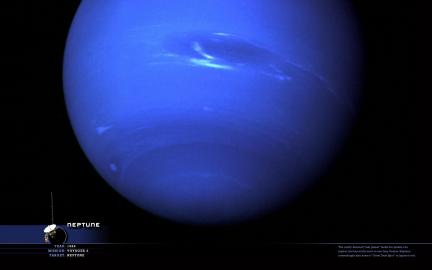 Neptune is the newly designated last “planet” in the solar system. It is the fourth gas giant and like Jupiter, it has its own “Great Red Spot” only in the case of Neptune it has been referred to as the “Great Dark Spot”. Like the other giants it also has a tenuous ring system and a system of moons. Only one of those moons, Triton, stands apart in size and characteristics and is one of the more interesting places to see in the solar system.
Neptune is the newly designated last “planet” in the solar system. It is the fourth gas giant and like Jupiter, it has its own “Great Red Spot” only in the case of Neptune it has been referred to as the “Great Dark Spot”. Like the other giants it also has a tenuous ring system and a system of moons. Only one of those moons, Triton, stands apart in size and characteristics and is one of the more interesting places to see in the solar system.
Wallpaper: Uranus Portrait
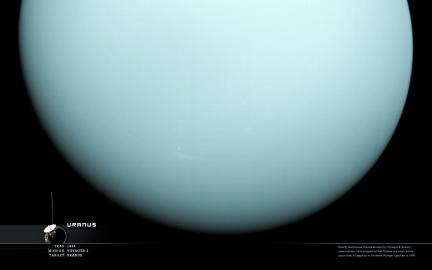 Second only to Mercury, Uranus tends to get the “boring” award from most due to its lack of almost any kind of cloud details. Among its five moons, there also isn’t really that much going on beyond what one might expect from such medium to small sized moons (with the possible exception of Miranda). However, there are a few things about Uranus that strike interest in it like the ring system, its axis is turned to about 98 degrees and more recently Hubble observations suggest that Uranus does have periodic cloud details not seen when Voyager flew past. As fate would have it, Uranus was in an unusually quiet mood in 1986.
Second only to Mercury, Uranus tends to get the “boring” award from most due to its lack of almost any kind of cloud details. Among its five moons, there also isn’t really that much going on beyond what one might expect from such medium to small sized moons (with the possible exception of Miranda). However, there are a few things about Uranus that strike interest in it like the ring system, its axis is turned to about 98 degrees and more recently Hubble observations suggest that Uranus does have periodic cloud details not seen when Voyager flew past. As fate would have it, Uranus was in an unusually quiet mood in 1986.
Wallpaper: Saturn Portrait
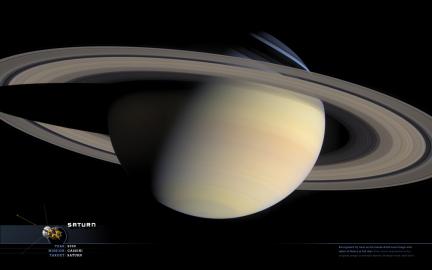 Usually the favorite of most due to its fabulous ring system which easily makes Saturn the most picturesque bodies in the solar system. It also has an extensive system of moons which makes Saturn, like Jupiter, almost a mini system within our Solar System. One of its moons, Titan, is more of a planet than some planets are in that it has a thick atmosphere, is large in size, has weather and recent radar images suggest an extensive system of methane/ethane rivers and lakes.
Usually the favorite of most due to its fabulous ring system which easily makes Saturn the most picturesque bodies in the solar system. It also has an extensive system of moons which makes Saturn, like Jupiter, almost a mini system within our Solar System. One of its moons, Titan, is more of a planet than some planets are in that it has a thick atmosphere, is large in size, has weather and recent radar images suggest an extensive system of methane/ethane rivers and lakes.
Wallpaper: Jupiter Portrait
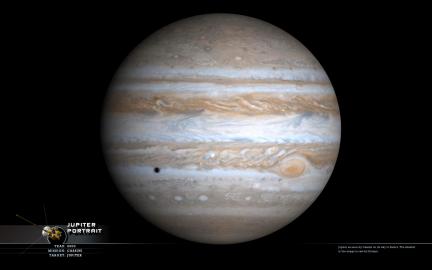 Jupiter is a mini system within our solar system. Had it become considerably more massive during the formation of the solar system, it may have ignited and given us a binary star system. It is quite large in comparison to the other planets and its mass is 2.5 greater than the combined mass of all the other planets in our system. The best feature of all is Jupiter’s system of four large moons, Io, Europa, Ganymede and Callisto. These moons are in their own right, more fascinating than many planets happen to be. For example, one of its moons (Europa) has become what many scientists are calling our Solar System’s “most likely place to currently harbor life”, other than Earth.
Jupiter is a mini system within our solar system. Had it become considerably more massive during the formation of the solar system, it may have ignited and given us a binary star system. It is quite large in comparison to the other planets and its mass is 2.5 greater than the combined mass of all the other planets in our system. The best feature of all is Jupiter’s system of four large moons, Io, Europa, Ganymede and Callisto. These moons are in their own right, more fascinating than many planets happen to be. For example, one of its moons (Europa) has become what many scientists are calling our Solar System’s “most likely place to currently harbor life”, other than Earth.
Wallpaper: Io Against Jupiter
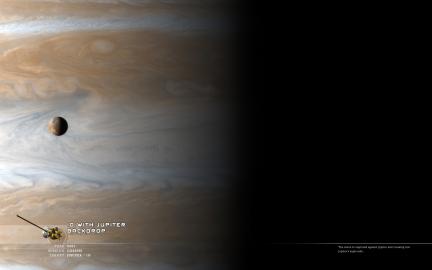 Io was observed against Jupiter here in this partial family portrait. Its close proximity to Jupiter is what tears the tiny moon apart internally and causes the large amount volcanism discovered by Voyager and monitored by Galileo. Oddly enough, this image was taken by Cassini on its way to Saturn during its gravity assist pass through the Jupiter system.
Io was observed against Jupiter here in this partial family portrait. Its close proximity to Jupiter is what tears the tiny moon apart internally and causes the large amount volcanism discovered by Voyager and monitored by Galileo. Oddly enough, this image was taken by Cassini on its way to Saturn during its gravity assist pass through the Jupiter system.
Wallpaper: Mars Portrait
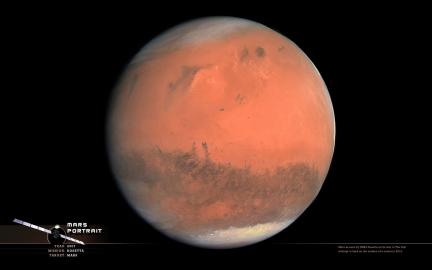 Mars is historically the most popular planet in our system. It has been the subject of many science-fiction stories as well as legitimate scientific investigation in the search for life outside of our own home. Recent missions to Mars have all but confirmed the idea that Mars was at one time a wet Earthlike place, covered rivers, seas and even oceans. Where all that water has gone is the subject of great interest and many have not given up the idea that we may one day still find some kind of life there if not the remains of life that had at one time thrived on the surface.The below wallpaper was the previous “portrait” image of Mars, but I have decided that the new Rosetta image of Mars captured during its gravity assist in 2007 is a better full globe image of the red planet. Notice the color variation… which is true? Well, the newer one from 2007 looks closer to Hubble views as seen from Earth orbit and unless they are manipulating colors from Hubble it would lead me to think that the Rosetta image is more honest.
Mars is historically the most popular planet in our system. It has been the subject of many science-fiction stories as well as legitimate scientific investigation in the search for life outside of our own home. Recent missions to Mars have all but confirmed the idea that Mars was at one time a wet Earthlike place, covered rivers, seas and even oceans. Where all that water has gone is the subject of great interest and many have not given up the idea that we may one day still find some kind of life there if not the remains of life that had at one time thrived on the surface.The below wallpaper was the previous “portrait” image of Mars, but I have decided that the new Rosetta image of Mars captured during its gravity assist in 2007 is a better full globe image of the red planet. Notice the color variation… which is true? Well, the newer one from 2007 looks closer to Hubble views as seen from Earth orbit and unless they are manipulating colors from Hubble it would lead me to think that the Rosetta image is more honest.
Wallpaper: Mercury Portrait
Sadly, Mercury has got to be the least interesting of the planets. It lacks any moons, lacks any substantial atmosphere and seems at a glance to be a duplicate of our own moon. At this point in time there has only been one mission to study Mercury up-close, Mariner 10 in 1973, so our information is quite limited. However, there is a mission on its way to Mercury right now named Messenger as well as a European/Japanese effort name Bepi-Columbo. Perhaps those missions will enlighten us all to things unseen on Mercury.
NOTE: This “portrait” wallpaper has been updated with a more recent color image taken during the January 2008 Messenger flyby.
Wallpaper: Mercury Up Close
No, its not our moon… its the planet Mercury. This is one of the best detailed images ever returned of Mercury and will likely remain so until Messenger reaches the planet in 2008 with an orbital insertion in 2011.
